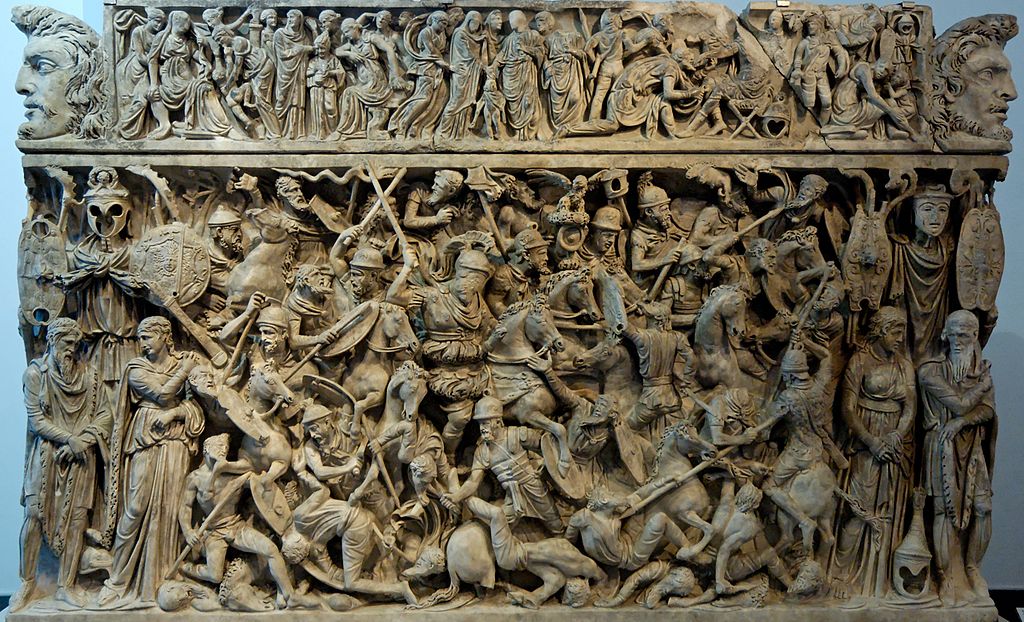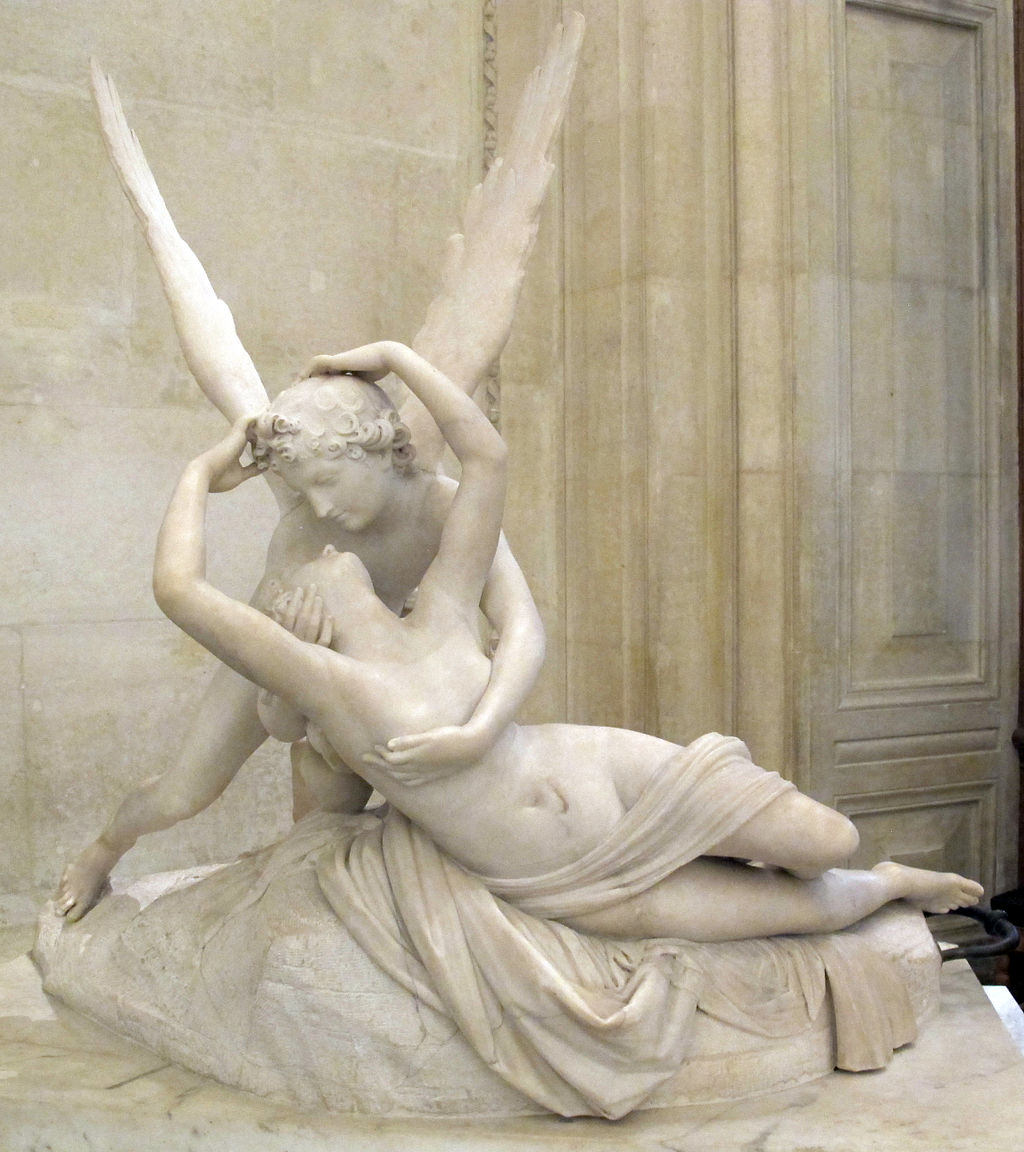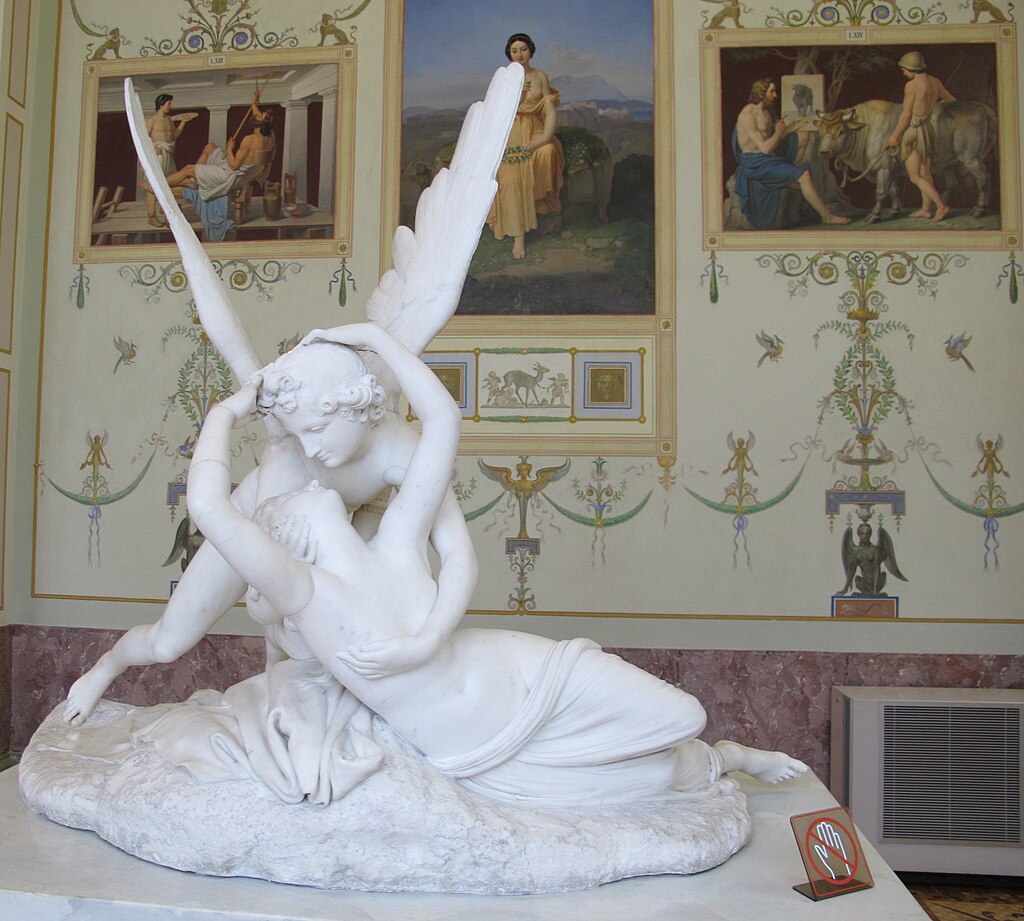“Psyche Revived by Cupid’s Kiss” by Antonio Canova shows the mythological lovers at a moment of high emotion. It represents the God Cupid in the height of love and tenderness, immediately after awakening Psyche with a kiss.
Having been awakened, Psyche reaches up toward her lover, Cupid, as he gently holds her by supporting her head and breast.
This sculpture exemplifies Antonio Canova’s craftsmanship and skills in carving marble that provides a superb contrast between the smooth skin of Psyche and Cupid as compared to the surrounding elements.
The detached draping around Psyche’s lower body, emphasizes the difference between the texture of skin and drapery. Beautiful curls and lines define the hair, and the feathery details create the realistic wings of Cupid.
The rough stone texture provides the basis of the rock upon which the composition is placed.
“Psyche Revived by Cupid’s Kiss” was first commissioned to Canova in 1787 by a British art collector and politician. This first version of the sculpture eventually became part of the Louvre Museum in Paris, France.
In 1796, a Russian nobleman acquired the 2nd version from Canova in Rome, and it later entered the Hermitage Museum in Saint Petersburg.
Cupid and Psyche
The story of Cupid and Psyche appears in Greek art as early as the 4th century BC. Still, the most extended source of the tale is the Latin novel Metamorphoses, also known as The Golden Ass, by Apuleius (2nd century AD).
The story’s theme concerns the overcoming of obstacles to the love between Psyche (“Soul” or “Breath of Life”) and Cupid, and their last union in marriage.
Psyche’s story includes the theme of dangerous curiosity, punishments and tests, and redemption through divine favor.
The back story is that the fame of Psyche’s beauty threatened to eclipse that of Venus herself. So the love goddess sent Cupid to work her revenge.
Cupid, however, becomes enamored with Psyche and rescues her by hiding her in his palace. He visits her by night, warning her not to try to look upon him.
Psyche’s envious sisters convince her that her lover must be a hideous monster, and she finally uses a lamp in their chamber to see him.
Startled by his beauty, she drips hot oil from the lamp and wakes him. He then abandons her because she broke her bond.
“Psyche Revived by Cupid’s Kiss” by Antonio Canova (Louvre)
Psyche then is trapped wandering the earth looking for him, and in desperation, submits to the service of Venus. The goddess sends Psyche on a series of quests.
Each time she despairs, and each time she is given divine aid. On her last task, she is required to retrieve a dose of Proserpina’s beauty from the underworld.
She succeeds, but on the way back, she can’t resist opening the box in the hope of benefitting from it herself, after which she falls into a lifeless sleep.
Cupid finds her in this lifeless state and revives her by returning the sleep into the box. “Psyche Revived by Cupid’s Kiss” is the climax of the story, after which Cupid grants Psyche immortality so they can be wed as equals.
Thus Psyche became the goddess of the soul and the wife of Eros or the Roman equivalent Cupid, the God of love.
Psyche Revived by Cupid’s Kiss (Louvre)
- Title: Psyche Revived by Cupid’s Kiss
- Artist: Antonio Canova
- Year: 1787-1793
- Place Created: Italy
- Medium: Marble
- Dimensions 155 cm × 168 cm (61 in × 66 in)
- Type: Mythological Art
- Museum: Louvre Museum in Paris, France
“Psyche Revived by Cupid’s Kiss” by Antonio Canova (Hermitage Museum)
“Psyche Revived by Cupid’s Kiss” by Antonio Canova (Hermitage Museum)
Cupid
In classical mythology, Cupid is the god of desire, erotic love, attraction, and affection. He is also known in Latin as Amor (“Love”). His Greek counterpart is Eros.
Cupid is the main character in the tale of Cupid and Psyche when wounded by his weapons, and he experiences the ordeal of love.
Although other extended stories are not told about him, his tradition is rich in poetic themes and visual scenarios, such as “Love conquers all” and the retaliatory punishment or torture of Cupid.
Greek Ideas for Love
Eros, the Ancient Greek God of love, gave his name to only one type of love for the Greeks. The Ancient Greek language distinguished at least six different types of love, each with a different word to explain the various kinds of love.
The six distinct words for love were: philía, éros, agápe, storgē, pragma, and philautia. It is difficult to distinguish the separate meanings of these words without carefully considering the context in which the terms are used.
- Philia
- Philia means love, as affectionate regard and friendship. It is a dispassionate virtuous love.
- Éros
- Eros means to love as sexual passion. The Modern Greek word “erotas” means “intimate love.”
- Agápe
- Agápe means love, with charity and good intent. The love of God for man and of man for God. The word Agape was used by early Christians to express the unconditional love of God for his children. This type of love was further explained by Thomas Aquinas as “to will the good of another.”
- Storge
- Storge means love, like tenderness, and affectionate attachment. The love of parents and children typifies this love.
- Pragma
- Pragma means love, as demonstrated by the partnership and mutual respect in a lengthy marriage.
- Philautia
- Philautia means love of self. The self-love or self-respect in the love for one’s self. This type of love can be seen as a suitable type of self-esteem but can also be harmful when it is dominated by conceitedness and egotism.
All these six types of love are generally seen as human and healthy forms of love. Still, at the extreme, they can also be destructive of the individual and society, as warned by the many examples in Ancient Greek Mythology and Philosophy.

Psyche Revived by Cupid’s Kiss (Hermitage Museum)
Psyche
In psychology, the Psyche is the totality of the human mind, conscious and unconscious. Psychology is the scientific study of the Psyche.
The word has a long history of use in psychology and philosophy, dating back to ancient times, and represents one of the fundamental concepts for understanding human nature. The word soul is sometimes used synonymously, especially in older texts.
The underlying meaning of the Greek word Psyche was “life” in the sense of “breath”, formed from the verb “to blow”. Derived meanings included “spirit” and “self.”
The association of “spirit” and “breath” is not unique to Greek cultures. The Chinese character for “spirit”, “soul” is the merging of the characters that are commonly used as “clouds” but also as “breath.”
The linkages between “spirit” and “breath” were formed independently by ancient people who did not have any contact with one another.
The idea of the Psyche is central to the philosophy of Plato. In his Phaedo, Plato has Socrates give four arguments for the immortality of the soul and life after death following the separation of the soul from the body.
Plato’s Socrates also states that after death, the Psyche is better able to achieve wisdom and experience the Platonic forms since it is unhindered by the body.
The story of Cupid and Psyche is about overcoming the obstacles to the love between Psyche (“Soul” or “Breath of Life”) and Cupid (“Desire” or “Eros”) and their ultimate union in a sacred marriage.
Psyche appears in Greek art as early as the 4th century BC.
Psyche Revived by Cupid’s Kiss (Hermitage Museum)
- Title: Psyche Revived by Cupid’s Kiss
- Artist: Antonio Canova
- Year: 1787-1793
- Place Created: Italy
- Medium: Marble
- Dimensions 155 cm × 168 cm (61 in × 66 in)
- Type: Mythological Art
- Museum: Hermitage Museum
Antonio Canova
Antonio Canova (1757 – 1822) was an Italian Neoclassical sculptor, famous for his marble sculptures. Canova was regarded as one of the greatest of the Neoclassical artists; the Baroque and the Classical Revival inspired his artwork. C
anova’s passion in sculptures were either Heroic compositions, compositions of Grace, or Tomb monuments. Canova was a highly recognized successful sculptor, and his skill and talent are evident in his work of “Psyche Revived by Cupid’s Kiss.”
Antonio Canova was born in the Venetian Republic. His father was a stonecutter, died when Canova was three years old.
Fortunately, he was put into the care of his paternal grandfather, who was a stonemason and a sculptor who specialized in altars with statues and low reliefs. His grandfather led Antonio into the art of sculpting.
At the age of nine, Antonio Canova executed two small shrines of Carrara marble, which are still in existence. After these works, he was employed under his grandfather as a sculptor.
Antonio Canova worked in Venice, Rome, France, and England, and by 1800, Canova was the most celebrated artist in Europe.
He promoted his reputation by publishing engravings of his works and having marble versions of plaster casts made in his workshop.
He was so successful that he had patrons from across Europe, including France, England, Russia, Poland, Austria, and Holland. In 1820, Canova made a statue of George Washington for the state of North Carolina.
Antonio Canova
- Name: Antonio Canova
- Born: 1757 – Possagno, Republic of Venice
- Died: 1822 (aged 64) – Venice, Lombardy–Venetia
- Nationality: Italian
- Movement: Neo-Classical
- Notable works:
- Psyche Revived by Cupid’s Kiss
- The Three Graces (Hermitage Museum)
- The Three Graces (Victoria and Albert Museum)
- Perseus with the Head of Medusa (Metropolitan Museum of Art – MET)
- Pauline Bonaparte as Venus Victrix
Psyche revived by Cupid’s kiss by Antonio Canova – Louvre, Paris
Antonio Canova (Italian, 1747-1822)
Introduction to Art History: Psyche Revived by Cupid’s Kiss
A Virtual Tour of the Louvre
- Paintings
- The Mona Lisa” by Leonardo da Vinci
- “Ruggiero Freeing Angelica” by Jean-Auguste-Dominique Ingres
- “The Valpinçon Bather” by Jean-Auguste-Dominique Ingres
- “The Turkish Bath” by Jean-Auguste-Dominique Ingres
- “Grande Odalisque” by Jean-Auguste-Dominique Ingres
- “Perseus and Andromeda” by Joachim Wtewael
- Self-portrait with Her Daughter, Julie by Louise Élisabeth Vigée Le Brun
- “The Virgin and Child with St. Anne” by Leonardo da Vinci
- “Louis XIV of France” by Hyacinthe Rigaud
- “The Massacre at Chios” by Eugène Delacroix
- “The Battle of San Romano” by Paolo Uccello
- “Virgin of the Rocks” by Leonardo da Vinci
- “The Death of Sardanapalus” by Eugène Delacroix
- “Psyche Revived by Cupid’s Kiss” by Antonio Canova
- “Liberty Leading the People” by Eugène Delacroix
- “The Arcadian Shepherds” by Nicolas Poussin
- “The Lacemaker” by Johannes Vermeer
- “The Money Changer and His Wife” by Quentin Matsys
- “The Fortune Teller” by Caravaggio
- “Portrait of Baldassare Castiglione” by Raphael
- “Charles I at the Hunt” by Anthony van Dyck
- “An Old Man and his Grandson” by Domenico Ghirlandaio
- “Vulcan Presenting Venus with Arms for Aeneas” by François Boucher
- “La belle ferronnière” by Leonardo da Vinci
- Self-Portrait by Élisabeth Sophie Chéron
- The Four Seasons by Nicolas Poussin
- “The Death of Marat” by Gioacchino Giuseppe Serangeli after Jacques-Louis David
- “Oath of the Horatii” by Jacques-Louis David
- “The Coronation of Napoleon” by Jacques-Louis David
- Egyptian Antiquities
- Hunters Palette
- Akhenaton and Nefertiti
- Seated Scribe
- Fayum Mummy Portrait –
- Near Eastern Antiquities
- Law Code of Hammurabi
- Gudea, Prince of Lagash
- Victory Stele of Naram-Sin
- Statue of Ebih-Il
- Greek, Etruscan, and Roman Collections
- The Winged Victory of Samothrace
- Venus de Milo
- Sculpture
- Tomb of Philippe Pot
- “Rebellious Slave” by Michelangelo
- “The Dying Slave” by Michelangelo
- Highlights of The Louvre
A Virtual Tour of the Hermitage Museum
- “Madonna Litta” attributed to Leonardo da Vinci
- Composition VI by Kandinsky
- “Portrait of Doña Antonia Zárate” by Francisco Goya
- “White House at Night” by Vincent van Gogh
- “The Three Graces” by Antonio Canova
- Egyptian Collection in the Hermitage Museum
- Gonzaga Cameo
- “Psyche Revived by Cupid’s Kiss” by Antonio Canova
Eros and Psyche: A Love Story Greek Mythology
Psyche Revived by Cupid’s Kiss
Psyche Revived by Cupid’s Kiss
~~~
“Every block of stone has a statue inside it, and it is the task of the sculptor to discover it.”
– Michelangelo
~~~
Photo Credit: 1) Sailko [CC BY 3.0 (https://creativecommons.org/licenses/by/3.0)], from Wikimedia Commons 2)I, Sailko [CC BY-SA 3.0 (http://creativecommons.org/licenses/by-sa/3.0/)] ; By Stebanoid (Own work) [CC BY-SA 3.0 (http://creativecommons.org/licenses/by-sa/3.0)], via Wikimedia Commons 2) CC BY-SA 2.5, Link Yair Haklai
Popular this Week








 Sponsor your Favorite Page
Sponsor your Favorite Page SEARCH Search for: Search Follow UsJoin – The JOM Membership Program
Sponsor a Masterpiece with YOUR NAME CHOICE for $5
Share this:
- Tweet



